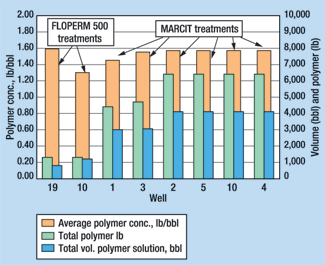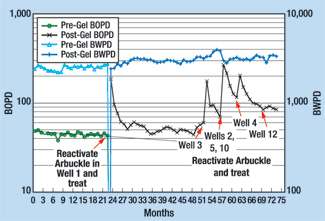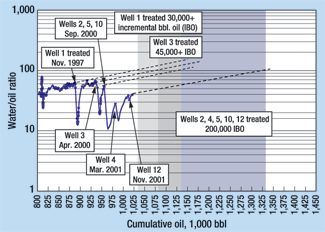Large-volume, gel-polymer treatments successful in Kansas's Arbuckle
Large-volume, gel-polymer treatments successful in Kansas’s ArbuckleCharlie Adams, Citation Oil and Gas Corp., Houston; and J. T. Portwood, * TIORCO, Inc., Ft. Worth, Texas Bottom line. Since 1997, TIORCO, Inc. has treated 21 Arbuckle wells in three Kansas fields – Bemis-Schutts (17 wells), North Hampton (3 wells) and Blue Hills (1 well) using its large-volume, proprietary MARCIT ** gel-polymer treatments. The economic success rate has been 100%, with payouts of total costs (polymer, plus well preparation and workover) less than six months. Incremental reserves are estimated at more than 540,000 bbl for three leases in Bemis-Schutts, or an average incremental of 39,000 bbl oil per well. Finding costs in three leases in the field range from $0.59 to $2.34 per incremental barrel of oil. Reduced water-handling costs alone exceed $1.4 million. Operator ultimate return on investment ranges from 8.5:1 to more than 17:1. Background. Especially in the Arbuckle, water production can be excessive due to channeling in this bottom-water-drive reservoir. High water production restricts oil production and increases operating costs, often leading to leases becoming prematurely uneconomic. Gel polymers have a long history in the Mid-Continent for blocking these channels. Building on this track record, TIORCO has experienced even more success using the proven gel technology licensed from Marathon and, significantly, much larger-volume treatments, i.e., 1,500 to 5,200 bbl, vs. conventional volumes of a few-hundred barrels. With these larger treating volumes, it can take one to several days to inject the polymer solution, so reliable equipment is a must. The new polymer technology. Dry polymer is mixed in water and crosslinked with chromium triacetate at the surface – as opposed to previous systems in which polymer and crosslinker mix in the reservoir. Gels having viscosity slightly greater than fresh water, to that of rubber, can be created in virtually any water, at temperatures up to 240°F, in high total-dissolved-solids, H2S and CO2 environments. Surface mixing, more robust formulations and simpler chemistry (only two chemicals) improve gel reliability. When selecting producer candidates, one should look for: 1) significant remaining mobile oil; 2) wells producing at or near their economic limit due to high water production; 3) wells with high fluid levels; 4) natural-water-drive reservoirs; and 5) high-permeability contrast between oil- and water-saturated rock, i.e., vuggy and/or fractured reservoirs. The new thinking on sizing treatments is to estimate daily-fluid capacity at maximum drawdown, and use an equivalent gel volume. Before pumping gel, the wellbore should be cleaned using 350 to 500 gal of 15% NEFE acid pumped away with water. Polymer-compatible biocide should be used in the mix water. If produced water is used to mix the gels, prior lab testing should be performed to confirm that the water is compatible with the new gel system. If fresh water is used, no compatibility tests are required. It is also preferred that fresh water be free of chlorine. Gel should be injected at a rate below or equal to the maximum producing rate, staying below the reservoir-parting pressure. Stages of increasing polymer concentration are normally used. Treatments should be over-displaced with oil or water to clear gel from near-wellbore, high-conductivity flow paths. Citation’s Arbuckle treating program. Since 1997, Citation Oil & Gas Corp. has treated seven Arbuckle producers in the Bemis-Schutts field using these larger-volume polymer gel treatments. Lease 1, in which these seven treatments were performed, illustrates the impact. Before that program, lease production was only 59 bopd from two Arbuckle producers and seven Topeka / Lansing Kansas City wells. The two Arbuckle producers alone produced 5,899 bwpd. By April 2001, two Arbuckle producers had been treated, five wells had been reactivated and treated in the Arbuckle, and one additional well had been treated with a cement / polymer system. In these treatments, polymer concentration was in the 1.1 to 1.6 lb/bbl range, Fig. 1. Except for a couple of lower-volume (900 to 1,100-bbl) treatments performed with technology that pre-dated MARCIT, polymer solution volumes were 3,000 to 4,000 bbl.
Fig. 2 illustrates the impact on daily oil production. Before treatment, oil production was about 45 bopd. Only two Arbuckle wells were producing. Seven Topeka/LKC wells were abandoned in the Arbuckle due to excessive water production (>3,000 bwpd/well). Gel treatment prevented significant water increase after reactivating the Arbuckle in seven wells. Following treatments, there were production spikes exceeding 200 bopd. Some four years following the first treatment, production was stabilizing in the 80 to 90-bopd range. Water / oil ratio (WOR) vs. cumulative trends illustrate the decreased WOR and realistic projection of incremental oil recovery, Fig. 3.
Economic results and lessons learned. For Citation’s Lease 1, incremental reserves are estimated at 409 Mbbl. With total costs of $940 M (treatments, reactivations, and artificial lift changes), this equates to about $2.30 per incremental barrel of oil. Significantly, at $0.12/bbl disposal costs, savings in water handling costs are about $1.4 million. Finding costs for all other treatments performed by TIORCO in the Kansas Arbuckle formation are between $1.16 and $2.34 per incremental barrel. These finding costs are consistent with the service company’s experience at the Citation lease. For maximum effectiveness, it is important that the wells be acidized before treating. When injecting polymer solution, one should end the treatment when surface pressure reaches 100 to 200 psi. To clear the gel from high-conductivity paths around the wellbore, overflush with either oil or water. In this instance, there was no obvious advantage to using oil. Volume is the key – use as much gel as is economically feasible. PTD
|
|||||||||||||||||||||||||||||||
- Shale technology: Bayesian variable pressure decline-curve analysis for shale gas wells (March 2024)
- What's new in production (February 2024)
- Prices and governmental policies combine to stymie Canadian upstream growth (February 2024)
- U.S. operators reduce activity as crude prices plunge (February 2024)
- U.S. producing gas wells increase despite low prices (February 2024)
- U.S. drilling: More of the same expected (February 2024)
- Applying ultra-deep LWD resistivity technology successfully in a SAGD operation (May 2019)
- Adoption of wireless intelligent completions advances (May 2019)
- Majors double down as takeaway crunch eases (April 2019)
- What’s new in well logging and formation evaluation (April 2019)
- Qualification of a 20,000-psi subsea BOP: A collaborative approach (February 2019)
- ConocoPhillips’ Greg Leveille sees rapid trajectory of technical advancement continuing (February 2019)





